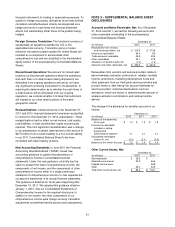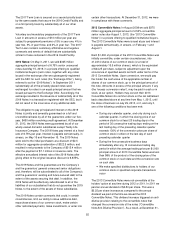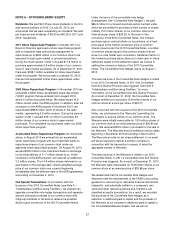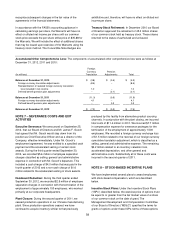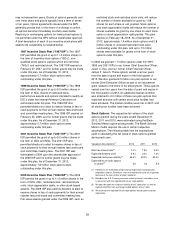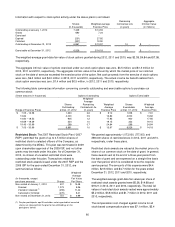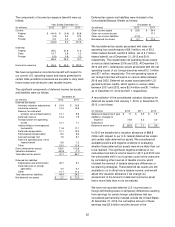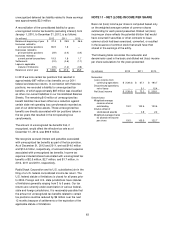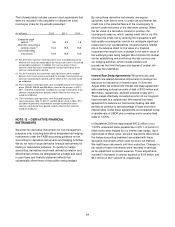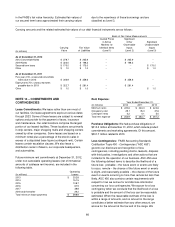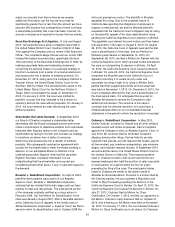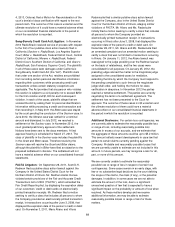Radio Shack 2012 Annual Report Download - page 61
Download and view the complete annual report
Please find page 61 of the 2012 Radio Shack annual report below. You can navigate through the pages in the report by either clicking on the pages listed below, or by using the keyword search tool below to find specific information within the annual report.
59
may not exceed ten years. Grants of options generally vest
over three years and grants typically have a term of seven
or ten years. Option agreements issued under the ISPs
generally provide that, in the event of a change in control,
all options become immediately and fully exercisable.
Repricing or exchanging options for lower priced options is
not permitted under the ISPs without shareholder approval.
A brief description of each of our incentive stock plans with
awards still outstanding is included below:
1997 Incentive Stock Plan (“1997 ISP”): The 1997
ISP permitted the grant of up to 11.0 million shares in
the form of incentive stock options (“ISOs”), non-
qualified stock options (options which are not ISOs)
(“NQs”) and restricted stock. The 1997 ISP expired on
February 27, 2007, and no further grants may be made
under this plan. As of December 31, 2012,
approximately 0.7 million stock options were
outstanding under this plan.
1999 Incentive Stock Plan (“1999 ISP”): The 1999
ISP permitted the grant of up to 9.5 million shares in
the form of NQs. Grants of restricted stock,
performance awards and options intended to qualify as
ISO’s under the Internal Revenue Code were not
authorized under this plan. The 1999 ISP also
permitted directors to elect to receive shares in lieu of
cash payments for their annual retainer fees and board
and committee meeting fees. The 1999 ISP expired on
February 23, 2009, and no further grants may be made
under this plan. As of December 31, 2012,
approximately 0.7 million stock options were
outstanding under this plan.
2001 Incentive Stock Plan (“2001 ISP”): The 2001
ISP permitted the grant of up to 9.2 million shares in
the form of ISOs and NQs. The 2001 ISP also
permitted directors to elect to receive shares in lieu of
cash payments for their annual retainer fees and board
and committee meeting fees. The 2001 ISP was
terminated in 2009 upon the shareholder approval of
the 2009 ISP and no further grants may be made
under this plan. As of December 31, 2012,
approximately 1.6 million stock options were
outstanding under this plan.
2009 Incentive Stock Plan (“2009 ISP”): The 2009
ISP permits the grant of up to 11.0 million shares in the
form of ISOs, NQs, restricted stock, restricted stock
units, stock appreciation rights, or other stock-based
awards. The 2009 ISP also permits directors to elect to
receive shares in lieu of cash payments for their annual
retainer fees and board and committee meeting fees.
Full-value awards granted under the 2009 ISP, such as
restricted stock and restricted stock units, will reduce
the number of shares available for grant by 1.68
shares for each share or unit granted. Stock options
and stock appreciation rights will reduce the number of
shares available for grant by one share for each stock
option or stock appreciation right granted. This plan
expires on February 18, 2019. As of December 31,
2012, approximately 1.4 million stock options and 0.8
million shares of unvested restricted stock were
outstanding under this plan, and up to 7.3 million
shares were available for grants in the form of stock
options under this plan.
In 2006 we granted 1.7 million options under the 1997,
1999 and 2001 ISPs to our former Chief Executive Officer,
Julian C. Day, and our former Chief Financial Officer,
James F. Gooch. These options vested over four years
from the date of grant and expire in the third quarter of
2013. We also granted 2.5 million non-plan options to our
former Chief Executive Officer as part of an inducement
grant related to the terms of his employment. These options
vested over four years from the date of grant and expire in
the third quarter of 2013. An additional market condition
was attached to 2.0 million of these non-plan options that
restricted exercise until certain stock price hurdles had
been achieved. The market condition was met in 2007, and
all stock price hurdles have been achieved.
Stock Options: The respective fair values of the stock
options granted during the years ended December 31,
2012, 2011 and 2010, were estimated using the Black-
Scholes-Merton option-pricing model. The Black-Scholes-
Merton model requires the use of certain subjective
assumptions. The following table lists the assumptions
used in calculating the fair value of stock options granted
during each year:
Valuation Assumptions
(1)
2012
2011
2010
Risk free interest rate
(2)
1.0%
1.6%
2.3%
Expected dividend yield 4.9%
2.0%
1.3%
Expected stock price volatility
(3)
55.4%
43.0%
42.4%
Expected life of stock options
(in years)(4)
5.5
5.4
5.4
(1) Forfeitures are estimated using historical experience and projected
employee turnover. Forfeitures were estimated to be zero for all periods
because of the low number of grant recipients.
(2) Based on the U.S. Treasury constant maturity interest rate whose term
is consistent with the expected life of our stock options.
(3) We consider both the historical volatility of our stock price, as well as
implied volatilities from exchange-traded options on our stock.
(4) We estimate the expected life of stock options based upon historical
experience.




